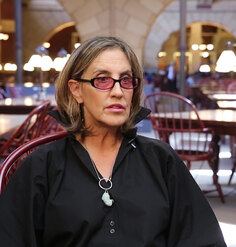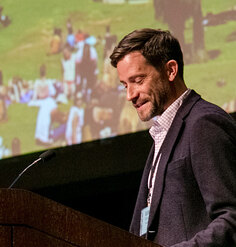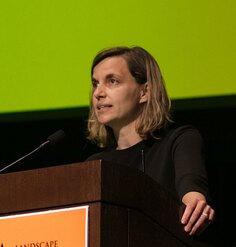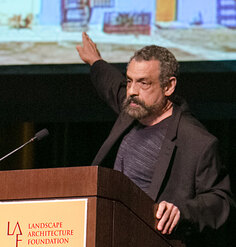Manifesto About the Profession's Future
By Martha Fajardo
This presentation was part of the Landscape Architecture Foundation’s The New Landscape Declaration: A Summit on Landscape Architecture and the Future held in Philadelphia on June 10-11, 2016. LAF asked a diverse group of leading minds to write a “Declaration” reflecting on the last half century and offering bold ideas for how landscape architecture can make its vital contribution in response to the challenges of our time.
Martha Fajardo
CEO, Grupo Verde Ltda
Chia, Cundinamarca, Colombia
Martha Fajardo is a Colombian architect and landscape architect with a master's degree in landscape design and an honorary doctor of letters (DLitt) from the University of Sheffield. She is cofounder and chief executive officer of Grupo Verde Ltda (GVL), a professional practice in landscape architecture, landscape urbanism, and urban design. She is also cofounder and chair of the Latin American Landscape Initiative (LALI).
* Affiliation at the time of the Summit
Manifesto About the Profession's Future
by Martha Fajardo
The major dynamics of the twenty-first century—global urbanization, natural disasters, and climate change—all involve landscape architecture. They are interrelated, and landscape architects can and must address them with scientific knowledge, holistic perspectives, and creative imagination. We stand at a critical moment in Earth’s history at which we must choose our future. We are living in a time of intense change with an amazing revival taking place as society, governments, and stakeholders begin to appreciate the true value of the landscape.
The adoption of the European Landscape Convention, the proposal for an IFLA/UNESCO1 International Landscape Convention, the UNESCO Recommendation on Historic Urban Landscape (HUL), the Florence Declaration on Landscape 2012, the Latin American Landscape Initiative (LALI), the Canadian Landscape Charter, the Asia Pacific Region Landscape Charter, and the African Landscape Charter have established landscape as a vital component of collective well-being; they have highlighted the need for its management at all scales throughout the regions, including urban and suburban, cities and towns, and areas with especially degraded everyday life, as well as places of highly valued heritage and natural significance.
Landscape is a shared vision in which, and to which, a vast array of disciplines converges and makes contributions. Such initiatives are gaining interest and support around the globe. We may have different approaches to landscape, and each culture and community may understand it in a different way, but landscape is a crucial component of all our daily lives.
The fact that landscape represents the direct experience of people in their day-to-day lives explains the growing interest in the landscape. People increasingly envision their local landscape as an engine for development and a way to boost self-esteem, identity, and quality of life.
Today we speak of landscape as a system of ecological services, as an expression of social relations, as an everyday experience, as a balance between designed open space and wild areas, as layers of meaning and values expressing life in a particular site. And this is all central to the identity of each place.
Nowadays, Latin America is brimming with new ideas and solutions. The landscape symbolizes a coming together of the natural world, human society, and people’s needs. Cultivating these initiatives demands a new type of professional. We champion the landscape and the landscape profession through advocacy and support, to inspire friendly and sustainable places where people want to visit, live, work, and feel they belong. For this reason, we need to work on the significance and power of the landscape and the need to accredit suitable university courses, to promote professional development, to ensure that landscape architects deliver the highest standards of practice, and to promote initiatives to foster international, regional, and local recognition of landscapes.
Landscape architects in Latin America are especially focused on working holistically on the social component. We must bear in mind and be aware of the identity of the people who shaped the Latin American soil. These people are diverse; they originated in diverse landscapes, which should house them and provide them with proper working conditions. People should be able to use their environment.
Landscape architects are closely linked to the design of environments in which human life elapses. Therefore, we are uniquely positioned to help protect existing ecosystems, to improve constructed human ones, and to regenerate those that were lost or damaged. We can do this with thorough, thoughtful intervention. We must cultivate professional recognition in order to continue with our task.
Landscape architects do not receive nearly as much recognition as urban planners usually do. It is now the time for landscape architecture to stand with a meaningful proposal that is responsive to our present challenges.
In the past decade, landscape has been the model and medium for the contemporary city. A wide range of alternative urban practices has emerged across the world. Many of these practices explore the ecological, cultural, and territorial implications for urban changes.
Our profession has increasingly evolved away from aesthetics, garden clubs, and parks into larger urban and rural scales. Sustainable infrastructure, community well-being, landscape resilience, and social ecology are core themes for the practice of contemporary landscape architecture. Through novel projects and new narratives, in Latin America we have ratified the role of the landscape architect in a more social and human-centered approach.
Through urbanism and landscape design, cities can be transformed to reach the level that present society demands. By adopting an inclusive and innovative approach to urban renewal, cities can achieve what they have long struggled for: creating a strong culture toward change.
Culturally sensitive landscape development acknowledges diversity and promotes the ability of individuals to participate freely in cultural life, in gaining access to cultural assets as well as building a culture for “living together,” helping to prevent tensions and confrontation. Thus, landscape architecture contributes to peace, conflict prevention, and reconciliation.
Landscape design has become more than greenery that heals decades of violence and fear. It is a strategically designed tool that opens civil society both physically and metaphorically.
The cities and landscapes of the future must be increasingly resilient and adaptable to changing environmental influences. Latin American natural disasters have shown the vulnerability of cities and villages. They also have proved the ability of humans to exacerbate the magnitude and intensity of man-made natural hazards. Postdisaster reconstruction provides an immense opportunity for landscape architects to enhance resilience, adaptability, and regeneration of their environment.
Thus, through our praxis, we have the opportunity to make a difference by creating resilient landscapes, affordable landscapes, and landscapes of happiness, where people are the most important resource, allowing us to build for happiness and well-being.
In synthesis, our work as landscape architects is about: acting now and tomorrow; connecting nature and culture; linking practice and landscape policy; influencing landscape change toward sustainability and resilience; expressing creativity, heritage, and a sense of belonging, knowledge, and diversity; addressing a transversal and crosscutting concern and, as such, affecting all the dimensions of development; and teaching people awareness of the meaning and value of landscape architecture.
1. IFLA is the International Federation of Landscape Architects and UNESCO is the United Nations Education, Scientific, and Cultural Organization.











